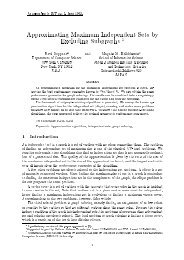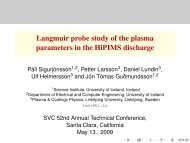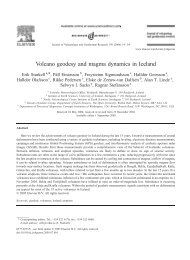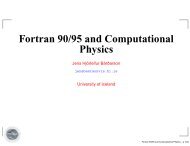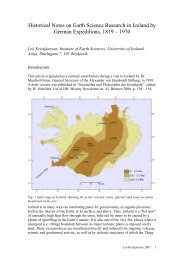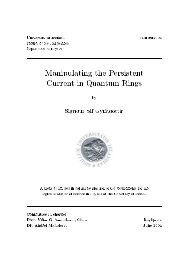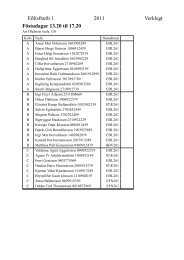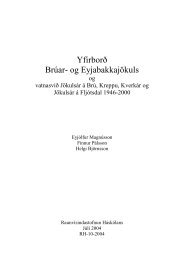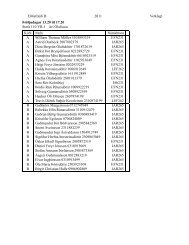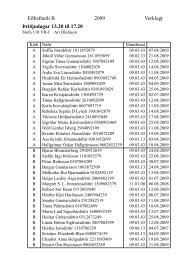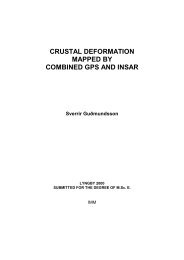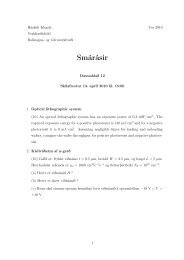High Power Impulse Magnetron Sputtering (HiPIMS)
High Power Impulse Magnetron Sputtering (HiPIMS)
High Power Impulse Magnetron Sputtering (HiPIMS)
You also want an ePaper? Increase the reach of your titles
YUMPU automatically turns print PDFs into web optimized ePapers that Google loves.
<strong>High</strong> <strong>Power</strong> <strong>Impulse</strong> <strong>Magnetron</strong> <strong>Sputtering</strong> (<strong>HiPIMS</strong>)<strong>High</strong> <strong>Power</strong> <strong>Impulse</strong> <strong>Magnetron</strong> <strong>Sputtering</strong>(<strong>HiPIMS</strong>)Jón Tómas GuðmundssonUniversity of Michigan – Shanghai Jiao Tong University Joint Institute,Shanghai Jiao Tong University, Shanghai, ChinaandScience Institute, University of Iceland, Icelandtumi@hi.isKorean Institute of Surface EngineeringSungkyunkwan University, Suwon Korea, May 31., 2012
<strong>High</strong> <strong>Power</strong> <strong>Impulse</strong> <strong>Magnetron</strong> <strong>Sputtering</strong> (<strong>HiPIMS</strong>)Introduction<strong>Magnetron</strong> sputtering has been the workhorse of plasmabased sputtering methods for over three decadesFor many applications a high degree of ionization of thesputtered vapor is desiredcontrolled ion bombardment of the growing film – controlledby a negative bias applied to the substratecollimation – enhanced step coverageIonized flux of sputtered vapor therefore introduces anadditional control parameter into the deposition process
<strong>High</strong> <strong>Power</strong> <strong>Impulse</strong> <strong>Magnetron</strong> <strong>Sputtering</strong> (<strong>HiPIMS</strong>)Outline<strong>Magnetron</strong> <strong>Sputtering</strong> DischargeIonized Physical Vapor Deposition (IPVD)<strong>High</strong> power impulse magnetron sputteringdischarge (<strong>HiPIMS</strong>)<strong>Power</strong> supplyVoltage - Current - timeElectronsIonsDeposition rateApplicationsSummary
<strong>High</strong> <strong>Power</strong> <strong>Impulse</strong> <strong>Magnetron</strong> <strong>Sputtering</strong> (<strong>HiPIMS</strong>)Planar <strong>Magnetron</strong> <strong>Sputtering</strong> Discharge
<strong>High</strong> <strong>Power</strong> <strong>Impulse</strong> <strong>Magnetron</strong> <strong>Sputtering</strong> (<strong>HiPIMS</strong>)Planar <strong>Magnetron</strong> <strong>Sputtering</strong> DischargeMagnetsGroundedshieldSNS−I dcV dc+s R CathodeSubstrateAnodeLFor a typical dc planar magnetron dischargepressure of 1 – 10 mTorra magnetic field strength of 0.01 – 0.05 Tcathode potentials 300 – 700 Vaverage power 200 – 600 Welectron density in the substrate vicinity is 10 15 − 10 17 m −3low fraction of the sputtered material is ionized ∼ 1 %the majority of ions are the ions of the inert gasthe sputtered vapor is mainly neutral
<strong>High</strong> <strong>Power</strong> <strong>Impulse</strong> <strong>Magnetron</strong> <strong>Sputtering</strong> (<strong>HiPIMS</strong>)From Gudmundsson (2008), J. Phys.: Conf. Ser. 100 082002In magnetron sputtering discharges increased ionized fluxfraction is achieved bya secondary discharge between the target and thesubstrate (rf coil or microwaves)reshaping the geometry of the cathode to get more focusedplasma (hollow cathode)increasing the power to the cathode (high power pulse)Common to all highly ionized magnetron sputteringtechniques is a very high density plasmaPlanar <strong>Magnetron</strong> <strong>Sputtering</strong> Discharge
<strong>High</strong> <strong>Power</strong> <strong>Impulse</strong> <strong>Magnetron</strong> <strong>Sputtering</strong> (<strong>HiPIMS</strong>)Ionized Physical Vapor Deposition (IPVD)
<strong>High</strong> <strong>Power</strong> <strong>Impulse</strong> <strong>Magnetron</strong> <strong>Sputtering</strong> (<strong>HiPIMS</strong>)Ionized Physical Vapor Deposition (IPVD)When the flux of ions is higher than the flux of neutrals orΓ i > Γ m the process is referred to as ionized physical vapordeposition (IPVD)The metal ions can be accelerated to the substrate bymeans of a low voltage dc biasThe metal ions arrive at the substrate at normal incidenceand at specific energyThe energy of the ions can be tailored to obtain impingingparticles with energies comparable to typical surface andmolecular binding energies
<strong>High</strong> <strong>Power</strong> <strong>Impulse</strong> <strong>Magnetron</strong> <strong>Sputtering</strong> (<strong>HiPIMS</strong>)Ionized Physical Vapor Deposition (IPVD)Ionizing the sputtered vapor has several advantages:improvement of the film quality, increased film density(Lim et al. (2000) JVSTA 18 524, Samuelsson et al. (2010) SCT 202 591)improved adhesion (Ehiasarian et al. (2007) JAP 101 054301)improved surface roughness (Sarakinos et al. (2007) JPD 40 2108)deposition on substrates with complex shapes and highaspect ratio (Alami et al. (2005) JVSTA 23 278)phase tailoring (Alami et al. (2007) TSF 515 3434)guiding of the deposition material to the desired areas ofthe substrate (Bohlmark et al. (2006) TSF 515 1928)hysteresis free reactive sputtering has been demonstratedin a <strong>HiPIMS</strong> discharge (Wallin and Helmersson (2008) TSF 516 6398)
<strong>High</strong> <strong>Power</strong> <strong>Impulse</strong> <strong>Magnetron</strong> <strong>Sputtering</strong> (<strong>HiPIMS</strong>)Ionized Physical Vapor Deposition (IPVD)The system design is determined by the average distancea neutral particle travels before being ionizedThe ionization mean free path isλ iz =v sk iz n ewherev s is the velocity of the sputtered neutral metalk iz is the ionization rate coefficientn e is the electron density
<strong>High</strong> <strong>Power</strong> <strong>Impulse</strong> <strong>Magnetron</strong> <strong>Sputtering</strong> (<strong>HiPIMS</strong>)Ionized Physical Vapor Deposition (IPVD)This distance has to be shortv s has to be low - thermalize the sputtered flux - increasedischarge pressuren e has to be highTypical parameters for argon gas and copper targetGas v s [m/s] T e [V] n e [m −3 ] λ iz [cm] DischargeAr 1000 a 3 10 17 162Ar 300 3 10 17 49 dcMSAr 300 3 10 18 4.9 ICP-MS/ECR-MSAr 300 3 10 19 0.5 <strong>HiPIMS</strong>Cu 300 1.5 10 19 7.5 SSS-<strong>HiPIMS</strong>a (Britun et al. (2008) APL 92 141503)
<strong>High</strong> <strong>Power</strong> <strong>Impulse</strong> <strong>Magnetron</strong> <strong>Sputtering</strong> (<strong>HiPIMS</strong>)Ionized Physical Vapor Deposition (IPVD)Another important parameter is the fraction of ionizedmetal fluxΓ iΓ i + Γ nThe ion flux to the substrate isΓ i ≈ 0.61n m+ u B ∼ √ T eThe flux of thermalized neutrals isΓ n = 1 4 n mv Th ∼√T gSince T e ≫ T g the fraction of ionized metal flux is largerthan the fraction of ionized metal in the plasmaIt is not necessary to completely ionize the sputtered metalto create a highly ionized flux to the substrate
<strong>High</strong> <strong>Power</strong> <strong>Impulse</strong> <strong>Magnetron</strong> <strong>Sputtering</strong> (<strong>HiPIMS</strong>)<strong>High</strong> <strong>Power</strong> <strong>Impulse</strong> <strong>Magnetron</strong> <strong>Sputtering</strong>(<strong>HiPIMS</strong>)
<strong>High</strong> <strong>Power</strong> <strong>Impulse</strong> <strong>Magnetron</strong> <strong>Sputtering</strong> (<strong>HiPIMS</strong>)<strong>High</strong> <strong>Power</strong> <strong>Impulse</strong> <strong>Magnetron</strong> <strong>Sputtering</strong> (<strong>HiPIMS</strong>)In a conventional dc magnetron dischargethe power density is limited by thethermal load on the targetIn a <strong>HiPIMS</strong> discharge a high powerpulse is supplied for a short periodlow frequencylow duty cyclelow average powerThe high power pulsed magnetronsputtering discharge uses the samesputtering apparatus except the powersupply
<strong>High</strong> <strong>Power</strong> <strong>Impulse</strong> <strong>Magnetron</strong> <strong>Sputtering</strong> (<strong>HiPIMS</strong>)<strong>HiPIMS</strong> - <strong>Power</strong> supplyThe high power pulsed discharge operates with aCathode voltage in the range of 500 – 2000 VCurrent densities of 3 – 4 A/cm 2<strong>Power</strong> densities in the range of 0.5 – 3 kW/cm 2Average power 200 – 600 WFrequency in the range of 50 – 5000 HzDuty cycle in the range of 0.5 – 5 %
<strong>High</strong> <strong>Power</strong> <strong>Impulse</strong> <strong>Magnetron</strong> <strong>Sputtering</strong> (<strong>HiPIMS</strong>)<strong>HiPIMS</strong> - <strong>Power</strong> supply<strong>High</strong> power pulsed magnetronsputtering (HPPMS)<strong>HiPIMS</strong>a pulse of very highamplitude, an impulse, isapplied to the cathode and along pause exists betweenthe pulsesModulated pulse power (MPP)the initial stages of the pulse(few hundred µs) the powerlevel is moderate (typical fora dcMS) followed by a highpower pulse (few hundred µsup to a ms)From Gudmundsson et al. (2012), JVSTA 30 030801<strong>Power</strong> density limitsp t = 0.05 kW/cm 2 dcMS limitp t = 0.5 kW/cm 2 <strong>HiPIMS</strong> limit
<strong>High</strong> <strong>Power</strong> <strong>Impulse</strong> <strong>Magnetron</strong> <strong>Sputtering</strong> (<strong>HiPIMS</strong>)<strong>HiPIMS</strong> - <strong>Power</strong> supply2000−20000V T[V]−400−600−800−1000−12002502001503 mTorr5 mTorr10 mTorr15 mTorr20 mTorr0 20 40 60 80 100 120t [µS]3 mTorr5 mTorr10 mTorr15 mTorr20 mTorrCathode current (A)-20-40-60-800 50 100 150-200-400-600-800Cathode voltage (V)I T[A]100Pulse time (µs)500−500 20 40 60 80 100 120t [µS]From Magnus et al. (2011a), TSF 520 1621From Sigurjonsson et al. (2009) 52nd SVC, p. 234The exact pulse shape is determined by the loadthe discharge formedit depends on the gas type and gas pressureand the electronics of the power supply
<strong>High</strong> <strong>Power</strong> <strong>Impulse</strong> <strong>Magnetron</strong> <strong>Sputtering</strong> (<strong>HiPIMS</strong>)<strong>HiPIMS</strong> - <strong>Power</strong> supply<strong>HiPIMS</strong> has already beendemonstrated on an industrial scale(Ehiasarian et al., 2006) 49th SVC, p. 349Due to the absence of a secondarydischarge in the reactor an industrialreactor can be upgraded to becomeIPVD device by changing the powersupplyThis may include both rotatingmagnetron sputtering discharge andunbalanced multimagnetron sputteringsystems referred to as closed fieldunbalanced multimagnetron systems(CFUBMS)
<strong>High</strong> <strong>Power</strong> <strong>Impulse</strong> <strong>Magnetron</strong> <strong>Sputtering</strong> (<strong>HiPIMS</strong>)<strong>High</strong> <strong>Power</strong> <strong>Impulse</strong> <strong>Magnetron</strong> <strong>Sputtering</strong>(<strong>HiPIMS</strong>) - Voltage - Current - Timecharacteristics
<strong>High</strong> <strong>Power</strong> <strong>Impulse</strong> <strong>Magnetron</strong> <strong>Sputtering</strong> (<strong>HiPIMS</strong>)<strong>HiPIMS</strong> - Voltage - Current - timeTo describe the dischargecurrent-voltage characteristicsthe current-voltage-time spaceis requiredThe early work on <strong>HiPIMS</strong>used 50 – 100 µs pulsesThe cathode voltage and thedischarge current depend onthe discharge gas pressureI d[A]V d[kV]0.20−0.2−0.4−0.6−0.8−1250200150100500−50(a)0.4 Pa2.7 Pa0 20 40 60 80 100 120t [µS](b)0.4 Pa2.7 Pa0 20 40 60 80 100 120t [µS]From Gudmundsson et al. (2012), JVSTA 30 030801
<strong>High</strong> <strong>Power</strong> <strong>Impulse</strong> <strong>Magnetron</strong> <strong>Sputtering</strong> (<strong>HiPIMS</strong>)<strong>HiPIMS</strong> - Voltage - Current - timeFor longer pulses the initialpressure dependent currentpeak is followed by a secondphase that is power andmaterial dependentThe initial phase is dominatedby gas ions, whereas the laterphase has a strongcontribution fromself-sputteringFor some materials, thedischarge switches into amode of sustainedself-sputteringFrom Anders et al. (2007, 2008),JAP 102 113303 and JAP 103 039901
<strong>High</strong> <strong>Power</strong> <strong>Impulse</strong> <strong>Magnetron</strong> <strong>Sputtering</strong> (<strong>HiPIMS</strong>)<strong>HiPIMS</strong> - Voltage - Current - timeA schematic illustration of thedischarge current assumingsquare shaped voltage pulsesThe current is generallycharacterized by an initial peakfollowed by a more or lessstable current plateau (bottomcurrent curves)In other cases it shows aninitial peak followed by asecond increase of thedischarge current (top currentcurves)From Gudmundsson et al. (2012), JVSTA 30 030801
<strong>High</strong> <strong>Power</strong> <strong>Impulse</strong> <strong>Magnetron</strong> <strong>Sputtering</strong> (<strong>HiPIMS</strong>)<strong>HiPIMS</strong> - Voltage - Current - timeThe self-sputtering can operate in a self-sustained mode,when the ions of the sputtered vapor are created at highenough rate that the ions of the working gas are notneededThe condition for sustained self-sputtering is expressed asΠ ss = αβ t Y ss = 1whereα is the probability of ionization of the sputtered atomβ t in the probability that the newly formed ion of thesputtered vapor returns to the targetY ss is the self-sputter yield of the ionThis is a steady state situation and the current remainsconstant
<strong>High</strong> <strong>Power</strong> <strong>Impulse</strong> <strong>Magnetron</strong> <strong>Sputtering</strong> (<strong>HiPIMS</strong>)<strong>HiPIMS</strong> - Voltage - Current - timeNote that since α < 1 and β t < 1 the condition Y ss > 1 isnecessary but not sufficient for achieving sustainedself-sputteringThe transient phase of self-sputtering runaway occurswhen Π ss > 1Self-sputtering runaway occurs at a well-defined thresholdpower, determined by the discharge voltage and is readilyobtained for high sputter yield materialsBut runaway can also occur at lower threshold voltagesthan for pure self-sputtering as well as for ransition metalsand target materials of low sputter yield due to what isreferred to as ’gas recycling’ runawayAnders (2011), SCT 205 S1, Anders et al. (2012) JPD 45 012003
<strong>High</strong> <strong>Power</strong> <strong>Impulse</strong> <strong>Magnetron</strong> <strong>Sputtering</strong> (<strong>HiPIMS</strong>)<strong>HiPIMS</strong> - Voltage - Current - timeThe bottom curve represents arange of low self-sputtering,Π ss < 0.1 and the dischargephysics in the plateau/runawayphase is dcMS-likeThe middle range of powerdensities, with 0.1 < Π ss < 1,represents partiallyself-sputtering dischargeThe top curve representsself-sputtering runaway whichrequires Π ss > 1 and aself-sputter yieldY ss > 1/(αβ t ) > 1From Gudmundsson et al. (2012), JVSTA 30 030801
<strong>High</strong> <strong>Power</strong> <strong>Impulse</strong> <strong>Magnetron</strong> <strong>Sputtering</strong> (<strong>HiPIMS</strong>)<strong>HiPIMS</strong> - Voltage - Current - timeDuring reactive sputtering, areactive gas is added to theinert working gasThis changes the plasmacomposition by adding new ionspecies, and the targetcondition can also change dueto the formation of acompound on its surfaceFrom Magnus et al. (2012), JVSTA submittedThe current waveform of Ar/O 2discharge is highly dependenton the repetition frequency andapplied voltage which is linkedto oxide formation on the target
<strong>High</strong> <strong>Power</strong> <strong>Impulse</strong> <strong>Magnetron</strong> <strong>Sputtering</strong> (<strong>HiPIMS</strong>)<strong>HiPIMS</strong> - Voltage - Current - timeSimilarly the current waveformin the reactive Ar/N 2 <strong>HiPIMS</strong>discharge is highly dependenton the pulse repetitionfrequency, unlike for pure ArThe current is found toincrease significantly as thefrequency is loweredThis is attributed to anincrease in the secondaryelectron emission yield duringthe self-sputtering phase,when the nitride forms on thetarget at low frequenciesFrom Magnus et al. (2011b) JAP 110 083306
<strong>High</strong> <strong>Power</strong> <strong>Impulse</strong> <strong>Magnetron</strong> <strong>Sputtering</strong> (<strong>HiPIMS</strong>)<strong>HiPIMS</strong> - Voltage - Current - timeAt high frequencies, a nitride is notable to form between pulses, andself-sputtering by Ti + -ions (singlyand multiply charged) from a Titarget is the dominant processAt low frequency, the long off-timeresult in a nitride layer being formedon the target surface andself-sputtering by Ti + - and N + -ionsfrom TiN takes placeThe observed changes in thedischarge current are reflected in theflux of ions impinging on thesubstrateFrom Magnus et al. (2011b), JAP 110 083306
<strong>High</strong> <strong>Power</strong> <strong>Impulse</strong> <strong>Magnetron</strong> <strong>Sputtering</strong> (<strong>HiPIMS</strong>)<strong>High</strong> <strong>Power</strong> <strong>Impulse</strong> <strong>Magnetron</strong> <strong>Sputtering</strong>(<strong>HiPIMS</strong>) - Electrons
<strong>High</strong> <strong>Power</strong> <strong>Impulse</strong> <strong>Magnetron</strong> <strong>Sputtering</strong> (<strong>HiPIMS</strong>)<strong>HiPIMS</strong> - Electron density(After Bohlmark et al. (2005), IEEE Trans. Plasma Sci. 33 346)Temporal and spatial variation of the electron densityAr discharge at 20 mTorr, Ti target, pulse length 100 µsThe electron density in the substrate vicinity is of the orderof 10 18 − 10 19 m −3
<strong>High</strong> <strong>Power</strong> <strong>Impulse</strong> <strong>Magnetron</strong> <strong>Sputtering</strong> (<strong>HiPIMS</strong>)<strong>HiPIMS</strong> - Electron densityFrom Gylfason et al. (2005) JPD 38 3417Each peak travels with a fixed velocity through the chamberThe peaks travel with a velocity of 5.3 × 10 3 m/s at 1 mTorr,1.7 × 10 3 m/s at 5 mTorr, and 9.8 × 10 2 m/s at 20 mTorr
<strong>High</strong> <strong>Power</strong> <strong>Impulse</strong> <strong>Magnetron</strong> <strong>Sputtering</strong> (<strong>HiPIMS</strong>)<strong>HiPIMS</strong> - Electron energyFrom Gudmundsson et al. (2009) JAP 105 123302The measured EEPF is Maxwellian-like during the pulse at3 (dashed) and 20 (solid) mTorr with a copper targethigh electron density leads to a Maxwellian-like low energypart of the EEPFthe depletion in the high energy part is due to the escape ofhigh energy electrons to the chamber walls and inelasticcollisions of high energy electrons
<strong>High</strong> <strong>Power</strong> <strong>Impulse</strong> <strong>Magnetron</strong> <strong>Sputtering</strong> (<strong>HiPIMS</strong>)<strong>HiPIMS</strong> - Electron energyFrom Gudmundsson et al. (2009) JAP 105 123302Temporal variation of the effective electron temperature100 mm below the target under the race-track (r = 40 mm)The electron energy decreases with increased dischargepressure
<strong>High</strong> <strong>Power</strong> <strong>Impulse</strong> <strong>Magnetron</strong> <strong>Sputtering</strong> (<strong>HiPIMS</strong>)<strong>HiPIMS</strong> - Electron density - summaryThe peak electron density is of theorder of 10 18 − 10 19 m −3Gudmundsson et al. (2001) APL 78 3427Gudmundsson et al. (2002) SCT 161 249A monotonic rise in plasma densitywith discharge gas pressureGudmundsson et al. (2002) SCT 161 249applied power Alami et al. (2005) PSST 14 525A linear increase in electron densitywith increased discharge currentAfter Bohlmark et al. (2005)Ehiasarian et al. (2008) JAP 104 083305
<strong>High</strong> <strong>Power</strong> <strong>Impulse</strong> <strong>Magnetron</strong> <strong>Sputtering</strong> (<strong>HiPIMS</strong>)<strong>HiPIMS</strong> - Electrons - summaryThe electron density depends on thetarget materialCr target gives higher density than TiVetushka and Ehiasarian (2008) JPD 41 015204The peak electron density travels awayfrom the target with fixed velocityGylfason et al. (2005) JPD 38 3417The electron energy distributionfunction (EEDF) during the pulse isMaxwellian-likeGudmundsson et al. (2009) JAP 105 123302After Bohlmark et al. (2005)
<strong>High</strong> <strong>Power</strong> <strong>Impulse</strong> <strong>Magnetron</strong> <strong>Sputtering</strong> (<strong>HiPIMS</strong>)<strong>High</strong> <strong>Power</strong> <strong>Impulse</strong> <strong>Magnetron</strong> <strong>Sputtering</strong>(<strong>HiPIMS</strong>) - Ions
<strong>High</strong> <strong>Power</strong> <strong>Impulse</strong> <strong>Magnetron</strong> <strong>Sputtering</strong> (<strong>HiPIMS</strong>)<strong>HiPIMS</strong> - Ionization fractionConventional dcmagnetron discharge -Pre-ionization - violetargon discharge<strong>HiPIMS</strong> dischargeaveraged over severalpulses - green dischargecharacteristic of Cu vaporThe Cu + lines are onlyobserved in <strong>HiPIMS</strong> modeFrom Va˘sina et al. (2007) PSST 16 501
<strong>High</strong> <strong>Power</strong> <strong>Impulse</strong> <strong>Magnetron</strong> <strong>Sputtering</strong> (<strong>HiPIMS</strong>)<strong>HiPIMS</strong> - Ionization fractionThere have been conflicting reports onthe fraction of ionized metal flux70 % for Cu Kouznetsov et al. (1999) SCT 122 29056 % for Cu Vlček et al. (2007a) JVSTA 25 4299 % for Ti Kudláček et al. (2008) PSST 17 02501040 % for Ti 0.5 Al 0.5 Macák et al. (2000) JVSTA 18 15339.5 % for Al DeKoven et al. (2003) 46th SVC p. 1584.5 % for C DeKoven et al. (2003) 46th SVC p. 158The degree of ionization90 % for Ti Bohlmark et al. (2005) JVSTA 23 18The fraction of ionized metal fluxdepends on applied power, pulsefrequency and pulse length, and distancefrom the targetFrom Bohlmark et al. (2005)
<strong>High</strong> <strong>Power</strong> <strong>Impulse</strong> <strong>Magnetron</strong> <strong>Sputtering</strong> (<strong>HiPIMS</strong>)<strong>HiPIMS</strong> - Ionization fractionThe ion flux versus timemeasured by a massspectrometer (20 µswindows)The gas pressure was 3mTorr, pulse energy 8 Jand the target made of Ti<strong>High</strong>ly metallic ion fluxduring the active phase ofthe dischargeFrom Bohlmark et al. (2006) TSF 515 1522
<strong>High</strong> <strong>Power</strong> <strong>Impulse</strong> <strong>Magnetron</strong> <strong>Sputtering</strong> (<strong>HiPIMS</strong>)<strong>HiPIMS</strong> - Ionization fractionDuring the initial stages of thepulse Ar + ions dominate thedischargeLater in the pulse metal ionsbuild up and become theabundant ion speciesMultiply charged ions havebeen observedSignificant fraction of the ionflux is Ti 2+Bohlmark et al. (2006) TSF 515 1522Ti 4+ ions have beenobservedAndersson et al. (2008) APL 93 071504From Bohlmark et al. (2006) 515 1522From Ehiasarian et al. (2002) Vacuum 65 147
<strong>High</strong> <strong>Power</strong> <strong>Impulse</strong> <strong>Magnetron</strong> <strong>Sputtering</strong> (<strong>HiPIMS</strong>)<strong>HiPIMS</strong> - Multiply charged ionsMultiply charged metal ions are crucialfor the transition of the discharge fromargon ion sputtering to self-sputteringSingly charged metal ions cannotcreate the secondary electronsnecessary to maintain metalself-sputtering (γ SE is practically zero)The first ionization energies of manymetals are insufficient to overcome theworkfunction of the target materialAnders et al. (2007) JAP 102 113303, Anders (2008) APL 92 201501From Anders (2008) APL 92 201501
<strong>High</strong> <strong>Power</strong> <strong>Impulse</strong> <strong>Magnetron</strong> <strong>Sputtering</strong> (<strong>HiPIMS</strong>)<strong>HiPIMS</strong> - Ion energyThe time averaged ionenergy distribution for Ar +and Ti + ionsThe gas pressure was 3mTorr, pulse energy 3 Jand 10 J and the targetmade of TiThe ion energy distributionis broad to over 100 eVAbout 50 % of the Ti +ions have energy > 20 eV From Bohlmark et al. (2006) TSF 515 1522
<strong>High</strong> <strong>Power</strong> <strong>Impulse</strong> <strong>Magnetron</strong> <strong>Sputtering</strong> (<strong>HiPIMS</strong>)<strong>HiPIMS</strong> - Ion energySignificant fraction of theTi + ions are transportedradially outwardsDirection dependent highenergy-tailFrom Lundin et al. (2008) PSST 17 035021
<strong>High</strong> <strong>Power</strong> <strong>Impulse</strong> <strong>Magnetron</strong> <strong>Sputtering</strong> (<strong>HiPIMS</strong>)<strong>HiPIMS</strong> - Charged particle transportIt has been observed thatthe electron cross-Btransport in <strong>HiPIMS</strong>discharges is much fasterthan classical collisiontheory predictsThe diffusion coefficient isroughly a factor 5 greaterthan what Bohm diffusionwould predictFrom Lundin et al. (2011) PSST 20 045003Brenning et al. (2009) PRL 103 225003Lundin et al. (2011) PSST 20 045003
<strong>High</strong> <strong>Power</strong> <strong>Impulse</strong> <strong>Magnetron</strong> <strong>Sputtering</strong> (<strong>HiPIMS</strong>)<strong>HiPIMS</strong> - Ionization fractionGasless self-sputtering ofcopper has beendemonstratedAndersson and Anders (2009) PRL 102 045003This self-sputtering invacuum can deliverextraordinarily highmetal-ion currentThe usable ion currentincreased exponentiallywith increasing dischargevoltage
<strong>High</strong> <strong>Power</strong> <strong>Impulse</strong> <strong>Magnetron</strong> <strong>Sputtering</strong> (<strong>HiPIMS</strong>)<strong>High</strong> <strong>Power</strong> <strong>Impulse</strong> <strong>Magnetron</strong> <strong>Sputtering</strong>(<strong>HiPIMS</strong>) - Deposition rate
<strong>High</strong> <strong>Power</strong> <strong>Impulse</strong> <strong>Magnetron</strong> <strong>Sputtering</strong> (<strong>HiPIMS</strong>)<strong>HiPIMS</strong> - Deposition rateSeveral groups report on a significantly lowerdeposition rate for <strong>HiPIMS</strong> as compared todcMSa factor of 2 lower deposition rate for Cu andTi thin films(Bugaev et al., 1996) XVIIth Symp. Disc. Elec. Ins. Vac., p. 1074a factor of 3 – 7 lower deposition rate forreactive sputtering of TiO 2 from a Ti targetand AlO x from an Al targetDavis et al. (2004) 47th SVC, p. 215, Sproul et al. (2004) 47th SVC, p. 96the reduction in deposition rate decreaseswith decreased magnetic confinement(weaker magnetic field) Bugaev et al. (1996)a detailed study of various target materialsconfirms a consistently lower deposition rateSamuelsson et al. (2010) SCT 202 591From Samuelsson et al. (2010)
<strong>High</strong> <strong>Power</strong> <strong>Impulse</strong> <strong>Magnetron</strong> <strong>Sputtering</strong> (<strong>HiPIMS</strong>)<strong>HiPIMS</strong> - Deposition rateOne explanation is that the sputteredmaterial is ionized close to the target andmany of the metallic ions will be attractedback to the target surface by the cathodepotentialA reduction in the deposition rate wouldoccur mainly for metals with a lowself-sputtering yieldThe deposition rate in the self sputteringmode is lower than when argon sputtering isdominatingHorwat and Anders (2008) JPD 41 135210
<strong>High</strong> <strong>Power</strong> <strong>Impulse</strong> <strong>Magnetron</strong> <strong>Sputtering</strong> (<strong>HiPIMS</strong>)<strong>HiPIMS</strong> - Deposition rateIt has been claimed that the magneticconfinement influences the deposition rateBohlmark et al. (2006) TSF 515 1928, Bugaev et al. (1996)A significant fraction of the ions of thesputtered material are transported sidewaysLundin et al. (2008) PSST 17 035021Also when comparing dcMS and <strong>HiPIMS</strong>discharges at the same average power thenon-linear scaling of the sputter yield withthe applied voltage is not taken into accountEmmerlich et al. (2008) Vacuum 82 867The reduced deposition rate observed in the<strong>HiPIMS</strong> discharge is likely to be acombination of these factors
<strong>High</strong> <strong>Power</strong> <strong>Impulse</strong> <strong>Magnetron</strong> <strong>Sputtering</strong> (<strong>HiPIMS</strong>)<strong>High</strong> <strong>Power</strong> <strong>Impulse</strong> <strong>Magnetron</strong> <strong>Sputtering</strong>(<strong>HiPIMS</strong>) - Applications
<strong>High</strong> <strong>Power</strong> <strong>Impulse</strong> <strong>Magnetron</strong> <strong>Sputtering</strong> (<strong>HiPIMS</strong>)Application - Trench fillingTa thin films grown on Si substrates placed along a wall ofa 2 cm deep and 1 cm wide trenchconventional dc magnetron sputtering (dcMS)high power impulse magnetron sputtering (<strong>HiPIMS</strong>)Average power is the same 440 WSubstrate bias of - 50 VThey were compared by scanning electron microscope(SEM), transmission electron microscope (TEM)
<strong>High</strong> <strong>Power</strong> <strong>Impulse</strong> <strong>Magnetron</strong> <strong>Sputtering</strong> (<strong>HiPIMS</strong>)Application - Trench fillingFrom Alami et al. (2005) JVSTA 23 278dc magnetron<strong>HiPIMS</strong>dcMS grown films exhibit rough surface, pores betweengrains and inclined columnar structure, leaning toward theapertureTa films grown by <strong>HiPIMS</strong> have smooth surface, and densecrystalline structure with grains perpendicular to thesubstrate
<strong>High</strong> <strong>Power</strong> <strong>Impulse</strong> <strong>Magnetron</strong> <strong>Sputtering</strong> (<strong>HiPIMS</strong>)Application – Film DensityThe <strong>HiPIMS</strong> givesconsistently denser filmsThis illustrates how thebombarding ions transfermomentum to the surfaceallowing themicrostructure to bemodifiedFrom Samuelsson et al. (2010) SCT 202 591
<strong>High</strong> <strong>Power</strong> <strong>Impulse</strong> <strong>Magnetron</strong> <strong>Sputtering</strong> (<strong>HiPIMS</strong>)Application – Film ResistivityTiN as diffusion barriers incopper and aluminuminterconnects<strong>HiPIMS</strong> deposited films havesignificantly lower resistivity thandcMS deposited films on SiO 2 atall growth temperatures due toreduced grain boundaryscatteringThus, ultrathin continuous TiNfilms with superior electricalcharacteristics can be obtainedwith <strong>HiPIMS</strong> at reducedtemperaturesFrom Magnus et al. (2012) IEEE EDL accepted
<strong>High</strong> <strong>Power</strong> <strong>Impulse</strong> <strong>Magnetron</strong> <strong>Sputtering</strong> (<strong>HiPIMS</strong>)Summary
<strong>High</strong> <strong>Power</strong> <strong>Impulse</strong> <strong>Magnetron</strong> <strong>Sputtering</strong> (<strong>HiPIMS</strong>)SummaryThe design parameters for Ionized Physical VaporDeposition (IPVD) were discussedThe high power impulse magnetron sputtering discharge(HIPIMS) has been demonstrated as an Ionized PhysicalVapor Deposition (IPVD) tool<strong>Power</strong> supplyEssentially the same sputtering apparatus except for thepower supplyElectron densityRoughly 2 orders of magnitude higher in the substratevicinity than for a conventional dc magnetron sputteringdischarge
<strong>High</strong> <strong>Power</strong> <strong>Impulse</strong> <strong>Magnetron</strong> <strong>Sputtering</strong> (<strong>HiPIMS</strong>)SummaryIonization fractionIonization fraction is high, mainly due to the high electrondensityThe ions on the inert gas and the ions of the sputteredvapor are separated in timeDeposition rateDeposition rate is lower than in a conventional dcmagnetron sputtering discharge, maybe due to selfsputteringFilm qualityFilms deposited by <strong>HiPIMS</strong> are denser, more resistant tooxidation, smoother surfaces etc. – higher quality films areachieved at lower depostion temperature than by dcMS
<strong>High</strong> <strong>Power</strong> <strong>Impulse</strong> <strong>Magnetron</strong> <strong>Sputtering</strong> (<strong>HiPIMS</strong>)AcknowlegdementsThis work is a result of collaboration withDr. Jones Alami (Linköping University, Sweden now INI Coatings, Germany)Dr. Johan Bohlmark (Linköping University, Sweden now Sandvik A.B. Sweden)Dr. Sveinn Olafsson (University of Iceland)Prof. Ulf Helmersson (Linköping University, Sweden)Prof. Nils Brenning (KTH Stockholm)Dr. Friðrik Magnus (University of Iceland, now Uppsala University, Sweden)Dr. Daniel Lundin (Linköping University, Sweden)Petter Larsson (Linköping University, Sweden)Mattias Samuelsson (Linköping University, Sweden)Páll Sigurjónsson (University of Iceland now HS Orka)Dr. Kristinn B. Gylfason (University of Iceland now KTH Stockholm)Tryggvi K. Tryggvason (University of Iceland)Dr. Árni S. Ingason (University of Iceland now Linköping University, Sweden)This work was partially supported by the IcelandicResearch Fund the University of Iceland Research Fundand the Swedish Research Council.
<strong>High</strong> <strong>Power</strong> <strong>Impulse</strong> <strong>Magnetron</strong> <strong>Sputtering</strong> (<strong>HiPIMS</strong>)Acknowlegdementshttp://langmuir.raunvis.hi.is/∼tumi/hipims.htmlJ. T. Gudmundsson, N. Brenning, D. Lundin and U. Helmersson,<strong>High</strong> power impulse magnetron sputtering discharge, Journal ofVacuum Science and Technology A, 30(3) (2012) 030801The photographs were taken by Árni S. Ingason, Páll Sigurjónsson, Kristinn B. Gylfason and Markus Baur.
<strong>High</strong> <strong>Power</strong> <strong>Impulse</strong> <strong>Magnetron</strong> <strong>Sputtering</strong> (<strong>HiPIMS</strong>)ReferencesAlami, J., P. Eklund, J. M. Andersson, M. Lattemann, E. Wallin, J. Bohlmark, P. Persson, and U. Helmersson (2007).Phase tailoring of Ta thin films by highly ionized pulsed magnetron sputtering. Thin Solid Films 515(7-8),3434–3438.Alami, J., J. T. Gudmundsson, J. Bohlmark, J. Birch, and U. Helmersson (2005). Plasma dynamics in a highlyionized pulsed magnetron discharge. Plasma Sources Science and Technology 14(3), 525–531.Alami, J., P. O. A. Petersson, D. Music, J. T. Gudmundsson, J. Bohlmark, and U. Helmersson (2005). Ion-assistedphysical vapor deposition for enhanced film deposition on non-flat surfaces. Journal of Vacuum Science andTechnology A 23(2), 278–280.Anders, A. (2008). Self-sputtering runaway in high power impulse magnetron sputtering: The role of secondaryelectrons and multiply charged metal ions. Applied Physics Letters 92(20), 201501.Anders, A., J. Andersson, and A. Ehiasarian (2007). <strong>High</strong> power impulse magnetron sputtering: Current-voltage-timecharacteristics indicate the onset of sustained self-sputtering. Journal of Applied Physics 102(11), 113303.Anders, A., J. Andersson, and A. Ehiasarian (2008). <strong>High</strong> power impulse magnetron sputtering: Current-voltage-timecharacteristics indicate the onset of sustained self-sputtering. Journal of Applied Physics 103(3), 039901.Anders (2011). Discharge physics of high power impulse magnetron sputtering. Journal of AppliedPhysics 205(Supplement 2), S1-S9.Anders, A., J. Čapek, M. Hála and L. Martinu (2012). The ’recycling trap’: a generalized explanation of dischargerunaway in high-power impulse magnetron sputtering. Journal of Physics D: Applied Physics 45(1), 012003.Andersson, J. and A. Anders (2009). Self-sputtering far above the runaway threshold: An extraordinary metal-iongenerator. Physical Review Letters 102(4), 045003.Andersson, J., A. P. Ehiasarian, and A. Anders (2008). Observation of Ti 4+ ions in a high power impulse magnetronsputtering plasma. Applied Physics Letters 93(7), 071504.
<strong>High</strong> <strong>Power</strong> <strong>Impulse</strong> <strong>Magnetron</strong> <strong>Sputtering</strong> (<strong>HiPIMS</strong>)ReferencesBohlmark, J., J. Alami, C. Christou, A. P. Ehiasarian, and U. Helmersson (2005). Ionization of sputtered metals inhigh power pulsed magnetron sputtering. Journal of Vacuum Science and Technology A 23(1), 18–22.Bohlmark, J., J. T. Gudmundsson, J. Alami, M. Latteman, and U. Helmersson (2005). Spatial electron densitydistribution in a high-power pulsed magnetron discharge. IEEE Transactions on Plasma Science 33(2),346–347.Bohlmark, J., M. Lattemann, J. T. Gudmundsson, A. P. Ehiasarian, Y. A. Gonzalvo, N. Brenning, and U. Helmersson(2006). The ion energy distributions and ion flux composition from a high power impulse magnetron sputteringdischarge. Thin Solid Films 515(5), 1522–1526.Bohlmark, J., M. Östbye, M. Lattemann, H. Ljungcrantz, T. Rosell, and U. Helmersson (2006). Guiding thedeposition flux in an ionized magnetron discharge. Thin Solid Films 515(4), 1928–1931.Brenning, N., R. L. Merlino, D. Lundin, M. A. Raadu, and U. Helmersson (2009). Faster-than-bohm cross-B electrontransport in strongly pulsed plasmas. Physical Review Letters 103(22), 225003.Britun, N., J. G. Han, and S.-G. Oh (2008). Velocity distribution of neutral species during magnetron sputtering byFabry-Perot interferometry. Applied Physics Letters 92(14), 141503.Bugaev, S. P., N. N. Koval, N. S. Sochugov, and A. N. Zakharov (1996, July 21-26). Investigation of a high-currentpulsed magnetron discharge initiated in the low-pressure diffuse arc plasma. In XVIIth International Symposiumon Discharges and Electrical Insulation in Vacuum, 1996, Berkeley, CA USA, pp. 1074–1076. IEEE.Davis, J. A., W. D. Sproul, D. J. Christie, and M. Geisler (2004). <strong>High</strong> power pulse reactive sputtering of TiO 2 . In SVC47th Annual Technical Conferenece Proceedings, Dallas, TX, USA, pp. 215–218. Society of Vacuum Coaters.DeKoven, B. M., P. R. Ward, R. E. Weiss, D. J. Christie, R. A. Scholl, W. D. Sproul, F. Tomasel, and A. Anders(2003). Carbon thin film deposition using high power pulsed magnetron sputtering. In 46th Annual TechnicalConferenece Proceedings, San Francisco, CA, USA, pp. 158–165. Society of Vacuum Coaters.Ehiasarian, A. P., R. New, W.-D. Münz, L. Hultman, U. Helmersson, and V. Kouznetzov (2002). Influence of highpower densities on the composition of pulsed magnetron plasmas. Vacuum 65, 147–154.
<strong>High</strong> <strong>Power</strong> <strong>Impulse</strong> <strong>Magnetron</strong> <strong>Sputtering</strong> (<strong>HiPIMS</strong>)ReferencesEhiasarian, A. P., C. Reinhard, P. E. Hovsepian, and J. M. Colton (2006). Industrial-scale production ofcorrosion-resistant CrN/NbN coatings deposited by combined high power impulse magnetron sputtering etchingunbalanced magnetron sputtering deposition (HIPIMS/UBM) process. In SVC 49th Annual TechnicalConferenece Proceedings, Washington DC, USA, pp. 349–353. Society of Vacuum Coaters.Ehiasarian, A. P., A. Vetushka, A. Hecimovic, and S. Konstantinidis (2008). Ion composition produced by high powerimpulse magnetron sputtering discharges near the substrate. Journal of Applied Physics 104(8), 083305.Ehiasarian, A. P., J. G. Wen, and I. Petrov (2007). Interface microstructure engineering by high power impulsemagnetron sputtering for the enhancement of adhesion. Journal of Applied Physics 101(5), 054301.Emmerlich, J., S. Mráz, R. Snyders, K. Jiang, and J. M. Schneider (2008). The physical reason for the apparentlylow deposition rate during high power pulsed magnetron sputtering. Vacuum 82(8), 867–870.Gudmundsson, J. T., J. Alami, and U. Helmersson (2001). Evolution of the electron energy distribution and theplasma parameters in a pulsed magnetron discharge. Applied Physics Letters 78(22), 3427 – 3429.Gudmundsson, J. T., J. Alami, and U. Helmersson (2002). Spatial and temporal behavior of the plasma parametersin a pulsed magnetron discharge. Surface and Coatings Technology 161(2-3), 249–256.Gudmundsson, J. T. (2008). Ionized physical vapor deposition (IPVD): <strong>Magnetron</strong> sputtering discharges. Journal ofPhysics: Conference Series 100, 082002.Gudmundsson, J. T., P. Sigurjonsson, P. Larsson, D. Lundin, and U. Helmersson (2009). On the electron energy inthe high power impulse magnetron sputtering discharge. Journal of Applied Physics 105(12), 123302.Gudmundsson, J. T., N. Brenning, D. Lundin, and U. Helmersson (2012). <strong>High</strong> power impulse magnetron sputteringdischarge. Journal of Vacuum Science and Technology A 30(3), 030801.Gylfason, K. B., J. Alami, U. Helmersson, and J. T. Gudmundsson (2005). Ion-acoustic solitary waves in a pulsedmagnetron sputtering discharge. Journal of Physics D: Applied Physics 38(18), 3417–3421.Horwat, D. and A. Anders (2008). Spatial distribution of average charge state and deposition rate in high powerimpulse magnetron sputtering of copper. Journal of Physics D: Applied Physics 41(13), 135210.
<strong>High</strong> <strong>Power</strong> <strong>Impulse</strong> <strong>Magnetron</strong> <strong>Sputtering</strong> (<strong>HiPIMS</strong>)ReferencesKouznetsov, V., K. Macák, J. M. Schneider, U. Helmersson, and I. Petrov (1999). A novel pulsed magnetron sputtertechnique utilizing very high target power densities. Surface and Coatings Technology 122(2-3), 290–293.Kudláček, P., J. Vlekč, K. Burcalová, and J. Lukáš (2008). <strong>High</strong>ly ionized fluxes of sputtered titanium atoms inhigh-power pulsed magnetron discharges. Plasma Sources Science and Technology 17(2), 025010.Lim, J.-W., H.-S. Park, T.-H. Park, J.-J. Lee, and J. Joo (2000). Mechanical properties of titanium nitride coatingsdeposited by inductively coupled plasma assisted direct current magnetron sputtering. Journal of VacuumScience and Technology A 18(2), 524–528.Lundin, D., P. Larsson, E. Wallin, M. Lattemann, N. Brenning, and U. Helmersson (2008). Cross-field ion transportduring high power impulse magnetron sputtering. Plasma Sources Science and Technology 17(3), 035021.Lundin, D., S. A. Sahab, N. Brenning, C. Huo, and U. Helmersson (2011). Internal current measurements in highpower impulse magnetron sputtering. Plasma Sources Science and Technology 20(4), 045003.Macák, K., V. Kouznetzov, J. M. Schneider, U. Helmersson, and I. Petrov (2000). Ionized sputter deposition using anextremely high plasma density pulsed magnetron discharge. Journal of Vacuum Science and TechnologyA 18(4), 1533–1537.Magnus, F., A. S. Ingason, O. B. Sveinsson, S. Olafsson, and J. T. Gudmundsson (2011). Morphology of TiN thinfilms grown on SiO 2 by reactive high power impulse magnetron sputtering. Thin Solid Films 520(5), 1621–1624.Magnus, F., O. B. Sveinsson, S. Olafsson, and J. T. Gudmundsson (2011). Current-voltage-time characteristics ofthe reactive Ar/ N 2 high power impulse magnetron sputtering discharge. Journal of Applied Physics 110(8),083306.Magnus, F., T. K. Tryggvason, S. Olafsson, and J. T. Gudmundsson (2012). Current-voltage-time characteristics ofthe reactive Ar/O 2 high power impulse magnetron sputtering discharge. Journal of Vacuum Science andTechnology A submitted.
<strong>High</strong> <strong>Power</strong> <strong>Impulse</strong> <strong>Magnetron</strong> <strong>Sputtering</strong> (<strong>HiPIMS</strong>)ReferencesMagnus, F., A. S. Ingason, S. Olafsson, and J. T. Gudmundsson (2012). Nucleation and Resistivity of Ultrathin TiNFilms Grown by <strong>High</strong>-<strong>Power</strong> <strong>Impulse</strong> <strong>Magnetron</strong> <strong>Sputtering</strong>. IEEE Electron Device Letters accepted.Samuelsson, M., D. Lundin, J. Jensen, M. A. Raadu, J. T. Gudmundsson, and U. Helmersson (2010). On the filmdensity using high power impulse magnetron sputtering. Surface and Coatings Technology 202(2), 591–596.Sarakinos, K., J. Alami, and M. Wuttig (2007). Process characteristics and film properties upon growth of TiO x filmsby high power pulsed magnetron sputtering. Journal of Physics D: Applied Physics 40(7), 2108–2114.Sigurjonsson, P., P. Larsson, D. Lundin, U. Helmersson, and J. T. Gudmundsson (2009). Langmuir probe study ofthe plasma parameters in the <strong>HiPIMS</strong> discharge. In Society of Vacuum Coaters 52nd Annual TechnicalConference Proceedings, Santa Clara, CA, USA, pp. 234–239. Society of Vacuum Coaters.Sproul, W., D. J. Christie, and D. C. Carter (2004). The reactive sputter deposition of aluminum oxide coatings usinghigh power pulsed magnetron sputtering (hppms). In SVC 47th Annual Technical Conferenece Proceedings,Dallas, TX, USA, pp. 96–100. Society of Vacuum Coaters.Va˘sina, P., M. Me˘sko, J. C. Imbert, M. Ganciu, C. Boisse-Laporte, L. de Poucques, M. Touzeau, D. Pagnon, andJ. Bretagne (2007). Experimental study of a pre-ionized high power pulsed magnetron discharge. PlasmaSources Science and Technology 16(3), 501–510.Vetushka, A. and A. P. Ehiasarian (2008). Plasma dynamic in chromium and titanium HIPIMS discharges. Journal ofPhysics D: Applied Physics 41(1), 015204.Vlček, J., P. Kudláček, K. Burcalová, and J. Musil (2007a). <strong>High</strong>-power pulse sputtering using a magnetron withenhanced plasma confinement. Journal of Vacuum Science and Technology A 25(1), 42–47.Wallin, E. and U. Helmersson (2008). Hysteresis-free reactive high power impulse magnetron sputtering. Thin SolidFilms 516(18), 6398 – 6401.



